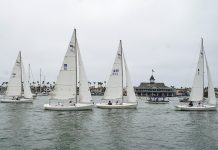By Steve Schupak
This past weekend Newport Harbor Yacht Club (NHYC) played host to the fifth annual Baldwin Cup Team Race. This international invitational team race has gained popularity and prestige each successive year. The 2012 even raised the bar even further, it’s hard to predict what could be done any better next year.
For those not tuned in to team racing, you have two teams race against each other with the winner determined by the best collective score. Typically raced in high school and college in dinghies and a three on three format, the Baldwin Cup is raced in Harbor 20’s using a four on four format. The advantage of the four on four is eliminates the easy to recognize winning combinations that three on three has. So quite often a team won’t know who won until after the finish boat has tabulated the scores for that race. There’s lots of drama, excitement, and nail biting maneuvers at the finish line.
As usual NHYC pulled all of the boats from their mooring field and created a stadium for the weekend. The main dock was alive with activity the entire weekend as teams switched in and out of boats, a commentators booth was erected two stories off the dock, music played, and let’s not forget the truck with $.25 beer all weekend for competitors and spectators alike. The atmosphere was festive, and you could get up close and talk with all of the racers.
For a very select group of national and international umpires they got an even closer look at the races. As with the racers who came from all over the US and the UK, the 18 strong umpire crew was assembled from the UK, Australia, Canada, and throughout the US. This is the group who’s either loved or hated in any given race. We follow right behind the action making instant judgments on rule infringements when the racers can’t decide on their own. This year was no exception with lots of flags flown, whistles blown indicating a foul or no foul, and in rare instances black flags indicating a hearing after the race might occur, where the umpires can straighten out a particularly vexing situation of issue.
With races starting every three minutes or so and lasting eight to twelve minutes, it’s hard to get a real overall perspective of who’s doing what until we get back to the dock at the end of the day. Because as soon as we finish one race we head back to the starting line to pick up the next. (For a more detailed race by race account and results please check out www.baldwincup.com) the one observation that I will pass along was that the wind, that had been very Newport-esque on Friday and Saturday was transformed to Storm Watch April 2012 with gusts in the low 20s common all day! And this had a transformative effect on how the races were sailed.
But when a race is on, it’s on! Each umpire boat has two umpires and three umpire teams per match, until the finals when you get four umpires per match for full coverage of the four on four race teams. Team racing differs from fleet racing in that it’s not a contest of pure speed, but one of control and speed. One team is constantly trying to control the other team to get themselves into a winning combination. 1,2,3,4 is a certain win, and 1,2,7,8 loses. So each team is constantly assessing where they and their teammates are to get into that winning combination. The course is set up in a digital N. Mark roundings are exercises in the mastery of rules, boat handling, nerve, and luck. A team can go into a mark trailing, but with a little effort, they can trap out the opposite team and leave a whole open for their own teammates to drive into and gain positions. This happens very quickly, and it’s here that the umpires have to anticipate where the “pressure point” is and position their boat to be able to see the transfer of rights from one boat to the other and make a call if requested by the competitors.
The other facet about team racing that’s counter intuitive is that you can often see a team member sailing away from a mark they have just rounded to go back against the grain, or sail back away from the finish line before finishing to help a team mate who is in trouble back down the course. One of the classic mottos for team racing is “friends don’t let friends finish last.”
The rule of thumb for a team race umpire that if they’re not in reverse half the time they’re too far from the action. You have to be close to see the action, and the competitors accept this as a condition of racing. So it’s not uncommon to be zipping in and out of a crowded situation and having a partner by your side that can help identify where unexpected boats pop into your vision is a huge help in avoiding umpire/competitor contact.
In the end, all the sailors had smiles on their faces. Some made big upsets against more experienced teams, some snatched defeat from the jaws of victory. For the umpires, it was a fantastic event sailed in a terrific stadium and over the top hospitality. All have said they are looking forward to being invited again.




